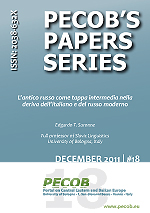and Balkan Europe
by IECOB & AIS Università di Bologna

Ancient Russian as an intermediate stage in the drift of Italian and modern Russian
L’antico russo come tappa intermedia nella deriva dell’italiano e del russo moderno
December 2011| #18

- December 2011 | #18
Abstract
The evolution of genetically related languages may sometimes result in a radical modification and differentiation of their structures. The author of this article uses the term shift to designate this kind of structural changes. The relevance of the shift may be increased by geographical and temporal distance.
There is a chronological asymmetry in the establishment and development of Italian and Russian. The forefathers of the two modern languages were Latin (established in the III-II centuries B.C.) and Old Church Slavonic (established in the XI-XII centuries A.D.). Italian became a literary language in the XIII-XIV centuries. Old literary Russian took shape in the XI-XII centuries; modern literary Russian asserted itself in the XVIII century. There is also a functional asymmetry between Latin, having had a long literary tradition before becoming a liturgical language, and Old Church Slavonic, which was codified on the basis of the Macedonian dialect of Thessalonica for apostolic and liturgical purposes.
East Slavonic dialects, i.e. Russian dialects, were merely oral in the VI-X centuries, while after 988 A.D. Old Church Slavonic (OCS) and the subsequent Russian Church Slavonic were essentially written linguistic vehicles. Literary Old Russian came into existence in the XII-XVI centuries and was at first a compromise between Church Slavonic and the spoken language. As time went by, the distance between OCS and Old Russian (both spoken and written) constantly increased, until they became two separated languages, in spite of some perduring reciprocal influence.
We can identify the shift which led to the considerable structural diversity between modern Italian and Russian in at least two crucial points: (a) the dominant correlation in the phonological consonantal subsystem (±geminate vs. ±palatalized) , (b) the different role (marginal vs. central) of the category of aspect in the verbal subsystem.
Although difference seems to be minor if we compare the vocalic subsystem in the two languages, the relative similarity is counterbalanced by a much greater diversity at the phonetic level. In fact, in modern Russian (in relation with the consonantal context and the position of the tonic accent) we can observe a strong tendency to neutralize phonemic oppositions, while in Italian the tendency towards phonemic neutralization is much more contained.
If we proceed to examine the verbal categories of tense and aspect, we notice – here as well – an opposite tendency in the two languages. Modern Italian (particularly in speech) tends to eliminate the autonomous expression of verbal aspect, “downloading” its content into the tense system (simple vs. compound or periphrastic forms) ; the modern Russian verb, on the contrary, is firmly pivoted around the category of aspect.
Old Russian (a language which is known to us mainly through its effects upon the written language) can typologically be considered an intermediate “stage” between the extremes reached by the two compared languages, for at least two factors:
- the marginality of the correlation ±palatalized (which is structurally non-existent in Italian) and
- the marginality of the category of aspect in relation to that of tense (which is dominant in Italian).
A direction opposite to that of Russian, in the Slavonic area, has been followed by modern Bulgarian. This language has preserved a verbal system close to that of Old Church Slavonic and early Old Russian and it is therefore characterized by a verbal system comparable to that of Italian. It can be added that Bulgarian, like Italian, has a definite article (although postponed) and has completely lost its ancient complex case system.
Keywords
structural shift, typology, phonological subsystem, verbal subsystem, Old Church Slavonic (OCS), Russian Church Slavonic, literary Old Russian, literary Italian, modern literary Russian
Table of contents
Abstract
Keywords
1. Alcuni riferimenti cronologici
2. Il concetto di struttura
3. Esempi di strutture a confronto: il sistema vocalico
4. Esempi dal sistema consonantico
5. Fonematica e fonetica
6. Diversi assetti del sistema verbale
7. Conclusione
Bibliografia
Download the paper
Version
Ver.: 01
Time stamp: 201112291219
PECOB: Portal on Central Eastern and Balkan Europe - University of Bologna - 1, S. Giovanni Bosco - Faenza - Italy
Chiudi la versione stampabile della pagina e ritorna al sito.
 Download the full paper!
Download the full paper!